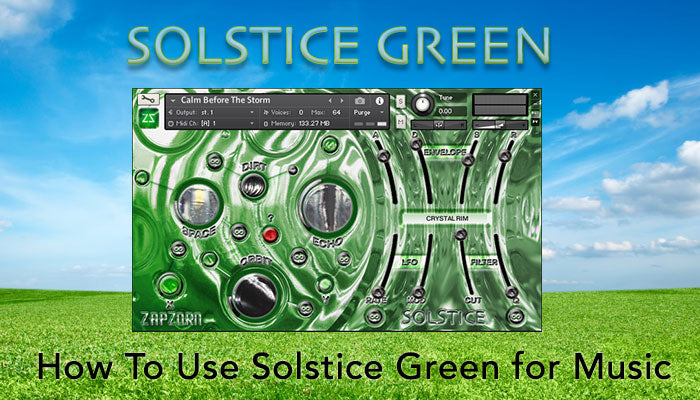Solstice Green: What Is It Made Of & How To Use It


Some of you have been wondering just what is in Solstice Green and how do you use Solstice products?
First - What is Solstice made of?
Nature sounds? Synth sounds? Organic Sounds? Let me set the record straight. Solstice Green is the next in the series of the Solstice line of randomly generated, sound design based pads and textures. Let me elaborate:
All Solstice products start with tonal based core sounds (looped so they can go on forever) - Green's core sounds (24 in total) consist of female vocals, male vocals, cello performances, blown pipes, flutes, guitar fades and e-bowing, bowed bowls, glass and stringed instruments and a few others. These are the tonal anchors in each patch. Then, to make it interesting, we add a secondary (X) and tertiary (Y) set of sounds - 24 of each set - These too are looped so they can go on forever - they are also randomized where they come in to keep it interesting. The X and Y sounds in Green range from natural things like thunderstorms, waterfalls, jungle ambience, streams, wind, the ocean… to more musical things like random harps, guitar and cello harmonics, wind chimes, prepared piano, blown bottles and more. THE MAGIC here is when you combine all of these together randomly to create an amazing combination of the three sound sets and add effects, filters and modulation. The key here is that nearly all of these sounds are ORGANIC in nature - real instruments, voices, soundscapes, etc. What makes that unique from a synth pad generator, is that organic sounds add nuances that don't exist in synths. To clear up any confusion, Solstice Green is very much a compositional tool - don't get side tracked by nature sounds and they are only used to make it more interesting.
So, how do you use Solstice?
Well, although there are lots of ways to use Solstice, one way is to use it to set the tone in a composition. When I scored A&E's Extreme Builds, I used Solstice Blue nearly in every cue to create a tonal background (or sometimes melody) that evolved and created a beautiful base to lay the rest of the cue on. It really made the cues sound completely unique. Let me show it through some examples:
SOLSTICE In Drama Cues:
The first 3 cues showcase how Solstice is used to set the tone in more random, non-rhythmic cues. On 'In A Hole,' Solstice is the background and the backbone of the piece where strings and piano play in and out of the Solstice bed. 'Betrayal' uses a combo of ZapZorn Elements and Solstice in the first :30 then Solstice entirely takes over for the rest of the piece creating real tension. On 'Drowning,' multiple layers of Solstice are the backbone of the piece that the piano and strings wither in and out of.
The next 3 drama cues showcase Solstice providing highlights and glue in rhythmic drama cues. 'Danger' shows some of the more uncomfortable Solstice sounds creating spikes in the tension while also providing a unique bed. In 'Stunned,' Solstice gives the bed along with the rhythm top right from the get go - then at 1:00 on, it provides a nice bed to lay under the cue. 'Bells,' uses a healthy dose of ZapZorn Elements to create the rhythm, but then once again utilizes Solstice's powerful glue to hold it together and provide a great background uniqueness - ending with the Solstice pad in the fade.
SOLSTICE In Lighter Cues:
Again, Solstice can be used to create an atmosphere in a cue dramatic or light. These light cues show how to create a cohesiveness and beauty using Solstice. In 'Coming Together,' a very light touch of Solstice is used to hold together the cue with a light and low bed in the background - it becomes more pervasive from :52 on and at 1:18 creates a tone that helps the cue complete. 'Pride and Joy,' one of the producers favorite cues, is simply hand claps, real hand drums, 2 guitars and Solstice gluing it all together. In the cue 'Letting Go,' Solstice adds a fantasy layer of complete beauty that cue is built on for the first 1:20, then the cue opens up and falls to the beautiful sounds of Solstice at 1:36 on - at the tail you can faintly hear the Solstice X and Y samples lightly touching the peace creating a mystery. Finally, in 'The High Road,' the cue starts just as another, but at :35 Solstice lightly touches the background and builds throughout the end to create another dimension that just edges the piece to a uniqueness that glues it all together.
As stated earlier, Solstice can be used in many ways, but in trying to clear up any misconceptions - Solstice Green and Blue are very much a tonal tool in a composers arsenal that can bring a complete uniqueness to what you compose. Furthermore, utilizing the red randomize button, YOU can create whatever sound you stumble across to be completely yours - and if your really adventurous, you can put your OWN sounds in Solstice to completely use it's powerful interface to transform your sounds.
For more on the randomization and use check out this randomization demo video here.
For more information or to buy Solstice Green go here -
Score on!
George Gabriel
